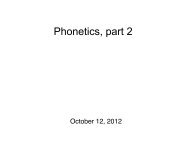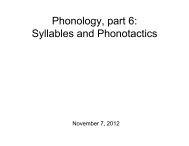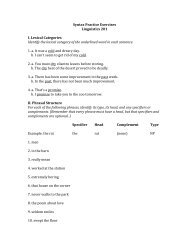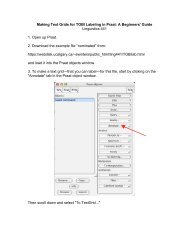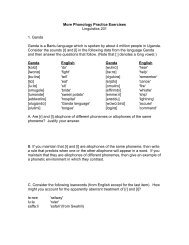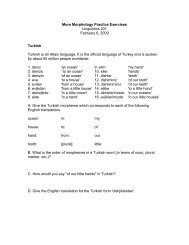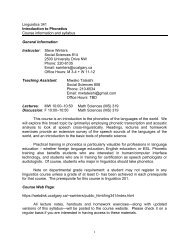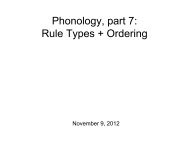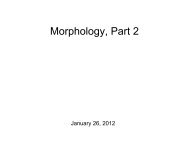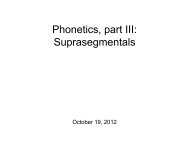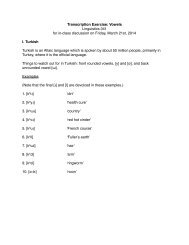Homework 3 - Basesproduced.com
Homework 3 - Basesproduced.com
Homework 3 - Basesproduced.com
Create successful ePaper yourself
Turn your PDF publications into a flip-book with our unique Google optimized e-Paper software.
Linguistics 201UCID#: _________________________<strong>Homework</strong> 3: PhonologyDue: Monday, November 9th, at 10 am1. (10 points) For each of the following (one-syllable) words, give an appropriatebroad phonetic transcription and clearly label the segments in the (i) onset, (ii)nucleus and (iii) coda of the syllable.a. starchb. depthsc. crimed. birdse. plunge2. (10 points) State the distinctive feature specifications which define thefollowing natural classes of English sounds.a. [f, θ, s, ʃ]b. [ɪ, ʊ]c. [n, r, l]d. [ɑ, o, ʌ, u, ʊ]e. [g, ŋ]
Linguistics 201UCID#: _________________________3. Phonological Processes (5 points)Below are some English words transcribed as they would be pronounced in slowspeech and in fast speech (by some, but not all speakers of English). Each wordundergoes a change from slow speech to fast speech which exemplifies aphonological process that we have discussed in class. Name the phonologicalprocess at work in each example.Spelling Slow Speech Fast Speech Processi) 'balloon' [bәlu:n] [blu:n]ii) 'gun powder' [gʌnpawɾr̩] [gʌmpawɾr̩]iii) 'diphthong' [dɪfθɑŋ] [dɪpθɑŋ]iv) 'asterisk' [æstәrɪsk] [æstәrɪks]v) 'else' [ɛls] [ɛlts]4. Burmese (5 points)The data below <strong>com</strong>e from Burmese, a Sino-Tibetan language spoken insoutheast Asia by about 32 million people.[ma] ʻhealthʼ [na] ʻpainʼ[nwe] ʻto flexʼ [n̥wej] ʻheat (verb)ʼ[n̥ej] ʻunhurriedʼ [mḁ] ʻorderʼ[m̥i] ʻflameʼ [nwa] ʻcowʼ[mjiʔ] ʻriverʼ [nḁ] ʻnostrilʼ[m̥on] ʻflourʼ [mi] ʻfiveʼDetermine whether the sounds [n], [m], [n̥] and [m̥] are allophones of the samephoneme or separate phonemes. If the sounds are separate phonemes, providea minimal pairs which show the contrast between them. If the sounds areallophones of the same phoneme, give:(i) the basic and restricted allophones(ii) the environment in which the restricted allophone appears(iii) the phonological rule accounting for the change between allophones
Linguistics 201UCID#: _________________________5. Dialects of English (5 points)One feature that distinguishes the American and British dialects of English is thedistribution of the [ju:] sequence. The data below show that this sequencesometimes does not appear in the American pronunciation of certain words, eventhough it does appear in the British pronunciation of the same words. (Note thatsome Canadian speakers follow the American pattern, and other Canadianspeakers follow the British pattern.)Word American Pronunciation British Pronunciation‘amuse’ [әmju:z] [әmju:z]‘beauty’ [bju:ɾi] [bju:ɾi]‘cube’ [k h ju:b] [k h ju:b]‘dupe’ [du:p] [dju:p]‘fume’ [fju:m] [fju:m]‘lurid’ [lu:rɪd] [lju:rɪd]‘news’ [nu:z] [nju:z]‘puny’ [p h ju:ni] [p h ju:ni]‘presume’ [p h rәzu:m] [p h rәzju:m]‘stupid’ [stu:pɪd] [stju:pɪd]‘suit’ [su:t] [sju:t](i) In what phonetic environment does [ju:] appear in the British pronunciations ofthese words, but not in the American pronunciations? The conditioningenvironment involves a natural class of sounds; state what that natural class is.(ii) Assuming that the underlying phonemic form in both dialects is /ju:/, write aformal phonological rule which accounts for the changes in the Americanpronunciation.
Linguistics 201UCID#: _________________________6. Spanish (5 points)Consider the sounds [d] and [ð] the data from Spanish below and then answerthe questions that follow. (Note that the Spanish [r] is phonetically different fromEnglish [r], but that fact is irrelevant to the solution of this problem.)[drama] 'drama' [komiða] 'food'[dolor] 'pain' [anda] 'scram'[dime] 'tell me' [sueldo] '<strong>com</strong>pensation'[kaða] 'each' [durar] 'to last'[laðo] 'side' [toldo] 'curtain'[oðio] 'hatred' [falda] 'skirt'Are the sounds [d], [ð] allophones of the same phoneme or separate phonemes?If the sounds are separate phonemes, provide evidence that there is a contrastbetween them. If the sounds are allophones of the same phoneme, give:(i) the basic and restricted allophones(ii) the environment in which the restricted allophone appears(iii) the phonological rule accounting for the distribution of the allophones
Linguistics 201UCID#: _________________________7. German (5 points)German has two fricatives which do not exist in American English: [ç], avoiceless palatal fricative, and [x], a voiceless velar fricative. Examine the databelow and then answer the questions that follow. (Note that [ɔ] is a mid, back,round vowel.)[axt] ‘eight’ [ɪç] ‘I’[bu:x] ‘book’ [ɛçt] ‘real’[lɔx] ‘hole’ [ʃpre:çә] ‘would speak’[ho:x] ‘high’ [lɛçәln] ‘to smile’[flʊxt] ‘flight’ [fɛçtәn] ‘to fence’(i) What distinctive feature distinguishes between palatal and velar sounds?(ii) In German, the fricatives [ç] and [x] are allophones of the same phoneme.Describe the phonetic contexts in which each allophone appears--in the simplestterms possible--using distinctive features.(iii) Write a phonological rule which accounts for the distribution of the twoallophones. (Note that it is not possible to determine, from this data set, whichallophone is basic, so simply choose either allophone as the underlying form andproceed from there.)
Linguistics 201UCID#: _________________________8. Bukusu (5 points)Bukusu is a Bantu language spoken in Kenya. In Bukusu, a prefix consisting of anasal segment is attached to a verb to indicate that it is in the first person (‘I eat’,‘I go’, ‘I sing’, etc.). However, sometimes this prefix appears on the phoneticsurface, and sometimes it does not. Look at the Bukusu data below and try todetermine what is happening in the language. (Note that [β] is a voiced bilabialfricative, and [x] is a voiceless velar fricative.)Verb RootFirst Person Form1. [di:la] 'hold' [ndi:la] ‘I hold’2. [se:nda] 'move' [se:nda] ‘I move’3. [gaβa] ‘divide’ [ŋgaβa] ‘I divide’4. [bi:ma] ‘weigh’ [mbi:ma] ‘I weigh’5. [xola] ‘do’ [xola] ‘I do’6. [buka] ‘perish’ [mbuka] ‘I perish’7. [fuka] ‘cook’ [fuka] ‘I cook’8. [funa] ‘break’ [funa] ‘I break’9. [suna] ‘jump’ [suna] ‘I jump’10. [xala] ‘cut’ [xala] ‘I cut’11. [geta] ‘pour’ [ŋgeta] ‘I pour’12. [dasa] ‘add’ [ndasa] ‘I add’13. [bula] ‘roam’ [mbula] ‘I roam’14. [dula] ‘trample’ [ndula] ‘I trample’15. [fwa:ra] ‘dress’ [fwa:ra] ‘I dress’16. [bala] ‘count’ [mbala] ‘I count’a. When does the nasal prefix appear at the beginning of the first person form,and when does it not? You should consider the phonetic properties of the stemverb when formulating your answer. Also, remember to state your answer interms of natural classes.b. When the prefix does appear on the phonetic surface, a phonological processoperates to change its phonetic shape. What is the name of this process?c. In the cases where the prefix does not appear in the first person form, assumethat a phonological process is at work that deletes the prefix. Write aphonological rule that accounts for this deletion process and also write aphonological rule which accounts for the process you named in part (b).



